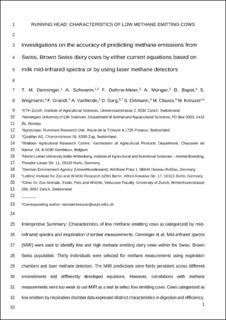| dc.contributor.author | Denninger, Thomas M | |
| dc.contributor.author | Schwarm, Angela Dagmar | |
| dc.contributor.author | Dohme-Meier, Frigga | |
| dc.contributor.author | Münger, Andreas | |
| dc.contributor.author | Bapst, Beat | |
| dc.contributor.author | Wegmann, Sylvia | |
| dc.contributor.author | Grandl, Florian | |
| dc.contributor.author | Vanlierde, Amélie | |
| dc.contributor.author | Sorg, Diana | |
| dc.contributor.author | Ortmann, Sylvia | |
| dc.contributor.author | Clauss, Marcus | |
| dc.contributor.author | Kreuzer, Michael | |
| dc.date.accessioned | 2020-10-26T09:30:28Z | |
| dc.date.available | 2020-10-26T09:30:28Z | |
| dc.date.created | 2019-11-02T22:19:40Z | |
| dc.date.issued | 2020 | |
| dc.identifier.citation | Journal of Dairy Science (JDS). 2020, 103 2024-2039. | en_US |
| dc.identifier.issn | 0022-0302 | |
| dc.identifier.uri | https://hdl.handle.net/11250/2684917 | |
| dc.description.abstract | Since heritability of methane (CH4) emissions in ruminants was demonstrated, various attempts to generate large individual animal CH4 data sets were initiated. Predicting individual CH4 emissions based on equations using milk mid-infrared (MIR) spectra is currently considered promising as a low-cost proxy. However, the predicted CH4 emission by MIR in individuals still has to be confirmed by measurements. In addition, it is still unclear how low CH4 emitting cows differ in intake, digestion,
and efficiency from high CH4 emitters. In the current study, putatively low and putatively high CH4 emitting Brown Swiss cows were selected from the entire Swiss herdbook population (176,611 cows), using a MIR-based prediction equation. Eventually, 15 low and 15 high CH4 emitters from 29 different farms were chosen for a respiration chamber (RC) experiment, where all cows were fed the same forage-based diet. A number of traits related to intake, digestion, and efficiency were quantified over 8 d, and CH4 emission was measured in 4 open circuit RC and daily CH4 emissions were also estimated using data from 2 laser CH4 detectors (LMD). The MIR-predicted CH4 production (g/d) was quite constant in low and high emission categories, and individuals across sites (home farm, experimental station), and within equations (first available and refined versions). The variation of the MIR-predicted values was substantially lower using the refined equation. However, the predicted low
and high emitting cows (n = 28) did not differ on average in daily CH4 emissions measured either with RC or estimated using LMD, and there was no correlation between CH4 predictions (MIR) and CH4 emissions measured by RC measurements. When re-categorized based on CH4 yield measured in RC, differences between categories of 10 low and 10 high CH4 emitters were about 20%. Low CH4
emitting cows had a higher feed intake, milk yield, and residual feed intake, but differed only weakly in eating pattern and digesta mean retention times. Low CH4 emitters were characterized by lower acetate and higher propionate proportions of total ruminal volatile fatty acids. We concluded that the current MIR-based CH4 predictions are not accurate enough to be implemented in breeding programs
for cows fed forage-based diets. In addition, low CH4 emitting cows have to be characterized in more detail using mechanistic studies to clarify in more detail the properties which explain the functional differences to other cows found. | en_US |
| dc.language.iso | eng | en_US |
| dc.rights | Attribution-NonCommercial-NoDerivatives 4.0 Internasjonal | * |
| dc.rights.uri | http://creativecommons.org/licenses/by-nc-nd/4.0/deed.no | * |
| dc.title | Accuracy of methane emissions predicted from milk mid-infrared spectra and measured by laser methane detectors in Brown Swiss dairy cows | en_US |
| dc.type | Peer reviewed | en_US |
| dc.type | Journal article | en_US |
| dc.description.version | acceptedVersion | en_US |
| dc.source.pagenumber | 2024-2039 | en_US |
| dc.source.volume | 103 | en_US |
| dc.source.journal | Journal of Dairy Science (JDS) | en_US |
| dc.identifier.doi | https://doi.org/10.3168/jds.2019-17101 | |
| dc.identifier.cristin | 1743498 | |
| dc.relation.project | Andre: Swiss State Secretariat for Education, Research and Innovat. | en_US |
| dc.relation.project | EU/COST Action FA 1302, “MethaGene” | en_US |
| dc.relation.project | Andre: Qualitas AG | en_US |
| cristin.unitcode | 192,10,1,0 | |
| cristin.unitname | Institutt for husdyr- og akvakulturvitenskap | |
| cristin.ispublished | true | |
| cristin.fulltext | postprint | |
| cristin.qualitycode | 2 | |

